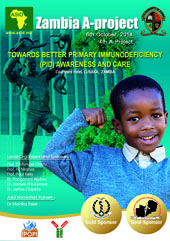Reem Elfeky1,2
1-Lecturer of Paediatrics, Ain Shams University, Cairo Egypt.
2-Fellow in Paediatric Immunology/Allergy, the Great North Children’s Hospital, the UK
Traduit par Dr L Jeddane (Maroc)
Des défauts génétiques sont la cause des déficits immunitaires primitifs (DIP), lesquels prédisposent aux infections.
Dix-sept patients issus de 7 familles non apparentées ont été évalués pour un profil clinique similaire comprenant une transmission autosomique dominante, des infections respiratoires récurrentes, une destruction des voies respiratoires, des infections virales et une néoplasie (tableau 1). Le bilan paraclinique a révélé une lymphopénie avec un taux faible de lymphocytes B mémoires switchés, des IgM élevées, des IgG2 basses, avec une faible réponse aux vaccins. L’analyse génétique a identifié une mutation dans le gène PIK3 CD résultant en une protéine suractivée appelée PI3K-p110 delta (1).
Les proteins PI3K sont essentielles pour la production de phosphoinositides, qui agissent comme messagers secondaires de la signalization intracellulaire dans de nombreux processus contrôlant la croissance et l’activité de nombreux types de cellules immunitaires. PI3K-p110 delta est spécifiquement impliquée dans les lymphocytes B et T (figures1-3) (1-3).
L’information génétique a permis aux chercheurs d’identifier et de cibler la protéine mTOR, un important signal qui est activé de façon excessive par la PI3K-p110 delta chez les patients APDS. Un patient a été traité avec la Rapamycine, un inhibiteur de mTOR, qui a restauré les lymphocytes T à un taux normal en 4 mois. Bien que la maladie n’ait pas été guérie, la normalisation des lymphocytes T a été suffisante pour améliorer les symptômes (4).
Bien que la rapamycine soit actuellement utilisée pour la prise en charge des cas d’APDS, le seul traitement curatif est la greffe de cellules souches, qui semble cruciale pour gérer les infections et prévenir la transformation maligne.
Résumé des symptômes cliniques et immunologiques des patients présentant la mutation p110δ
|
Manifestation Clinique / Immunologique |
Patients |
Nombre/pourcentage |
|
Infections respiratoires et otites récurrentes (H. influenzae, S. pneumoniae) |
P1-17 |
17/17 (100) |
|
TDM prouvant une destruction large (dilatation des bronches) ou petite (atténuation de la mosaïque) des voies respiratoires |
P1-7,9,11-13,17 |
12/16 (75) |
|
Splénomégalie (avant le début des infections récurrentes) |
P2,3,5,6,8,9,13-16 |
10/17 (59) |
|
Formation d’abcès (Peau, glande salivaire, glande lacrymale ou dent) , cellulite orbitale |
P1,3,5-8,10 |
7/17 (41) |
|
Infection cause par un virus du groupe herpes (HSV, CMV, VZV, EBV) |
P3,8,12,13 (et la soeur décédée de P5/P6) |
4/17 (24) |
|
Lymphome de la zone marginale |
P13 |
1/17 (6) |
|
Taux d’IgG2 bas ou intermittents |
P2-7,10-13 |
10/11 (91) |
|
Taux d’IgM élevés ou intermittents |
P1-6,8-11,13-16 |
14/17 (82) |
|
Taux bas des anticorps anti-pneumocoques |
P1-4,7,9,11-13,17 |
10/10 (100) |
|
Taux bas des anticorps anti-Haemophilus Influenzae type B |
P1-4,8,9,12,13 |
8/10 (80) |
|
Diminution des Lymphocytes T circulants (CD3+ total) et/ou T CD4+ et/ou T CD8+ |
P1-9,13,14,17 |
12/17 (71) |
|
Diminution des Lymphocytes B circulants (CD19+) |
P2-9,13,14-16 |
12/17 (71) |
|
Augmentation des lymphocytes B transitionnels circulants (CD19+CD38+IgM+) |
P1-4,7-14,16,17 |
14/16 (88) |
|
Diminution des lymphocytes B éemoires switchés (CD19+CD27+IgD−) |
P1-3,8,9,12,13,16 |
8/16 (50) |
D’après Angulo et al; 2013



Reference:
1- Angulo I, Vadas O, Garçon F, Banham-Hall E, Plagnol V, Leahy TR, Baxendale H, Coulter T, Curtis J, Wu C, Blake-Palmer K, Perisic O, Smyth D, Maes M,Fiddler C, Juss J, Cilliers D, Markelj G, Chandra A, Farmer G, Kielkowska A, Clark J, Kracker S, Debré M, Picard C, Pellier I, Jabado N, Morris JA, Barcenas-Morales G, Fischer A, Stephens L, Hawkins P, Barrett JC, Abinun M, Clatworthy M, Durandy A, Doffinger R, Chilvers ER, Cant AJ, Kumararatne D, Okkenhaug K,Williams RL, Condliffe A, Nejentsev S. Phosphoinositide 3-kinase δ gene mutation predisposes to respiratory infection and airway damage. Science.2013, 15;342(6160):866-71.
2- Koyasu S. The role of PI3K in immune cells. Nature immunology.2003, 4(4):313-318.
3- Lucas CL, Kuehn HS, Zhao F, Niemela JE, Deenick EK, Palendira U, Avery DT, Moens L, Cannons JL, Biancalana M, Stoddard J, Ouyang W, Frucht DL, Rao VK, Atkinson TP, Agharahimi A, Hussey AA, Folio LR, Olivier KN, Fleisher TA, Pittaluga S, Holland SM, Cohen JI, Oliviera JB, Tangye SG, Schwartzberg PL, Lenardo MJ, and Uzel G. Dominant-activating germ line mutations in the gene encoding the PI3K subunit p110d result in T cell senescence and human immunodeficiency. Nat Immunol. 2014 Jan;15(1):88-97.
4- Tzenaki N, Papakonstanti EA. p110δ PI3 kinase pathway: emerging roles in cancer. Front. Oncol. 2013; 4:1-18.



























